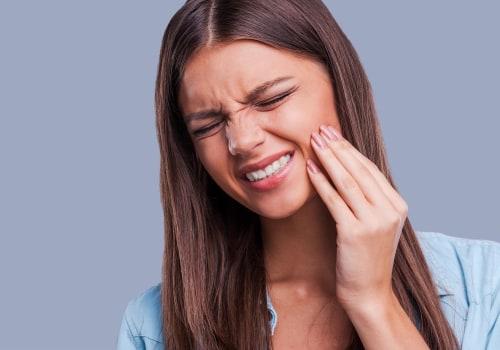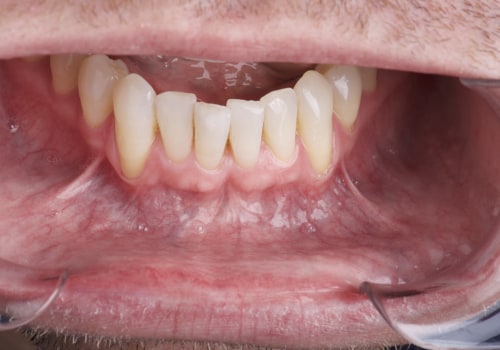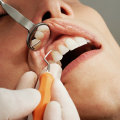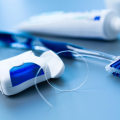Smoking or tobacco use is one of the leading causes of gum disease, a serious condition that can lead to tooth loss and other oral health problems. Fortunately, there are many ways to avoid smoking or using tobacco, and to prevent and manage gum disease. In this article, we'll discuss the best strategies for avoiding smoking and tobacco use, as well as the most effective methods for preventing and managing gum disease. Gum disease, or periodontal disease, is an infection of the gums and tissues that surround and support your teeth. It is caused by bacteria in plaque that builds up on the teeth due to poor oral hygiene.
If left untreated, gum disease can cause teeth to become loose or fall out, as well as cause infection in the jawbone and other areas of the mouth. Smoking and using tobacco products are known to increase the risk of developing gum disease. Smoking can make it harder for the body to fight off infection, while tobacco products can lead to an accumulation of plaque and tartar on teeth surfaces. Therefore, avoiding smoking and tobacco use can help reduce the risk of developing gum disease. Using tobacco or smoking cigarettes can have serious implications on the health of your gums and teeth. Smoking is associated with a greater risk of developing periodontal (gum) disease, which can lead to tooth loss and other serious health problems.
The dangers of smoking and using tobacco are numerous and include an increased risk of gum disease, cancer, and other health risks.
The dangers of smoking and using tobacco.
Smoking is a major risk factor for developing gum disease. Smoking makes it harder for the body to fight off bacteria that cause gum disease, and also makes it harder for the gums to heal after being damaged by plaque and tartar buildup. Additionally, smoking and using tobacco can weaken the immune system, making it more likely for bacteria to spread throughout the body.This can increase the risk of gum disease and other oral infections.
How smoking and tobacco use can increase your risk of developing gum disease.
Smoking increases the risk of periodontal disease in several ways. First, it reduces the amount of oxygen in the mouth, which makes it harder for the gums to heal after being damaged by plaque and tartar buildup. Second, smoking reduces the ability of the immune system to fight off bacteria that cause gum disease.Finally, smoking also contributes to a higher level of bacteria in the mouth, which can further increase the risk of periodontal disease.
Ways to quit smoking or using tobacco.
Quitting smoking or using tobacco can be a difficult process, but there are resources available to help make it easier. These include counseling, support groups, and prescription medications that can reduce cravings and make quitting easier. Additionally, setting a quit date and planning ahead can help make quitting easier.Prevention and management strategies to reduce the risk of gum disease. Quitting smoking or using tobacco is an important step in preventing or managing gum disease. Additionally, regular brushing and flossing, as well as regular visits to the dentist for professional cleanings, can help reduce the risk of gum disease. Eating a balanced diet and avoiding sugary foods can also help reduce the risk of gum disease.
Tips for avoiding relapse after quitting smoking or using tobacco.
Quitting smoking or using tobacco can be a difficult process, but it is possible.Tips for avoiding relapse after quitting include avoiding triggers such as certain people or places, finding healthy alternatives to smoking or using tobacco (such as exercising or meditating), and seeking support from family and friends. Additionally, creating a plan for dealing with cravings can help prevent relapse. The dental and overall health benefits of quitting smoking or using tobacco. Quitting smoking or using tobacco is one of the best things you can do for your health. Quitting reduces the risk of developing gum disease as well as other oral health problems such as tooth decay and bad breath.
Additionally, quitting also reduces the risk of cancer and other serious illnesses such as heart disease and stroke. Quitting also improves overall health by reducing stress levels, improving energy levels, and increasing overall wellbeing.
Relapse Prevention Tips
Quitting smoking or using tobacco is an important step towards improving your oral health, but it is not always easy. The risk of relapse is often very real, and it is important to be aware of the potential triggers and how to manage them. Below are some practical tips for avoiding relapse after quitting smoking or using tobacco.Avoid Triggers:
Certain people, places, or situations can trigger cravings to smoke or use tobacco.It is important to be aware of these potential triggers and try to avoid them. This can include people who smoke or use tobacco, places where you used to smoke or use tobacco, or any other situation that might make you want to start again.
Avoid Temptation:
When trying to stay away from smoking or using tobacco, it is important to avoid situations where you are likely to be tempted. This could include going to bars or clubs where you know people will be smoking, or being in a car with someone who smokes. Staying away from these situations can help keep you on track.Find Healthy Alternatives:
When cravings hit, it is important to find healthy ways to cope with them.Exercising, talking to friends or family members, or engaging in a hobby can all be great ways to distract yourself from the cravings and focus on something else. Finding healthy alternatives can help keep you on track when trying to quit smoking or using tobacco.
Prevention and Management Strategies
Using tobacco or smoking cigarettes can have serious implications on the health of your gums and teeth. Regular dental visits are essential for preventing and managing gum disease. Good oral hygiene practices such as brushing twice daily with fluoride toothpaste, flossing regularly, eating a balanced diet, avoiding sugary foods and drinks, limiting alcohol consumption, and rinsing your mouth out with an antiseptic mouthwash after brushing are important to maintain healthy gums and teeth. Brushing twice a day is an important part of preventing and managing gum disease.Brushing removes plaque, which is a sticky film that builds up on teeth, causing gum disease. Flossing regularly helps remove food particles and plaque from between the teeth and under the gum line. Eating a balanced diet helps to maintain healthy teeth and gums by providing the body with the nutrients it needs. Avoiding sugary foods and drinks can help reduce the risk of cavities.
Limiting alcohol consumption can help reduce the risk of gum disease. Rinsing your mouth out with an antiseptic mouthwash after brushing can help prevent gum disease. Antiseptic mouthwash helps to reduce the amount of bacteria in the mouth that can cause gum disease. It also helps to reduce bad breath and can freshen your breath.
The Dangers of Smoking and Using Tobacco
Smoking and using tobacco can have numerous adverse effects on your health, including an increased risk of developing periodontitis (a severe form of gum disease), tooth decay, oral cancer, heart disease, stroke, lung cancer, and chronic obstructive pulmonary disease (COPD).Nicotine, which is found in most forms of tobacco, is the primary cause of these health problems. Nicotine is a stimulant that raises your heart rate and increases your blood pressure.It also has a direct effect on your gums and teeth. Nicotine constricts blood vessels, reducing the amount of oxygen and nutrients that reach your gums. This can lead to inflammation and infection, as well as loss of bone and gum tissue. In addition to causing gum disease, smoking and using tobacco can also increase your risk of developing tooth decay. Tobacco smoke contains various chemicals that can damage your teeth.
These chemicals can stick to the surface of your teeth and increase the amount of bacteria present, leading to the formation of plaque and cavities. Smoking also affects your immune system, making it more difficult for your body to fight off infection. This can make it easier for bacteria to penetrate the gums and cause gum disease. Finally, smoking increases your risk of developing oral cancer. Tobacco smoke contains various carcinogenic substances that can damage cells in the mouth, leading to tumor formation.
How to Quit Smoking or Using Tobacco
Quitting Smoking or Using Tobacco: Quitting smoking or using tobacco can be difficult, but it is possible with the right approach. Before quitting, it is important to understand the various methods available and to seek help from a doctor or a quitline for advice.Some of the methods available include going cold turkey, gradually reducing the amount smoked or used, using nicotine replacement therapies such as patches, gum, or lozenges, joining a support group, or trying medication. When quitting smoking or using tobacco, it is important to set goals and reward yourself for reaching them. This can help to stay motivated and on track. Additionally, it helps to remove temptation by getting rid of ashtrays, lighters, and cigarettes or tobacco products from the home.
It is also important to keep track of triggers like certain activities or people that may lead to smoking or using tobacco again. Lastly, it can be helpful to find alternative activities like exercise or engaging in hobbies that will help keep the mind off smoking or using tobacco. Quitting smoking or using tobacco is a long process that requires patience and perseverance. But with the right approach and help, quitting is achievable.
Smoking and using tobacco can have serious implications on the health of your gums and teeth. It is important to take the necessary steps to avoid smoking and using tobacco in order to prevent and manage gum disease. Quitting smoking or using tobacco can be challenging, but with the right strategies, it can be done. Prevention and management strategies include developing healthy habits, avoiding triggers, and seeking support from your healthcare provider.
Relapse prevention tips such as understanding the risks, being aware of triggers, and having strategies in place can also help you stay on track. If you are considering quitting smoking or using tobacco, it is important to talk to your dentist or doctor for more information. With the right support, you can successfully quit smoking or using tobacco and keep your gums and teeth healthy.






